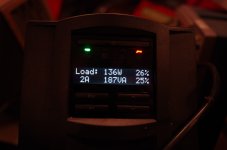Ohh.. I have a server battery backup which should be able to tell me the same information.. I'll try it.
I don't remember the drain current, but will check sometime. I think I modified the resistors to the 'recommended' values for the new jfets, whenever the f2J design was first being shared, but I don't remember anymore. I might run down right now to see my UPS will tell me the watts of that amp.
I don't remember the drain current, but will check sometime. I think I modified the resistors to the 'recommended' values for the new jfets, whenever the f2J design was first being shared, but I don't remember anymore. I might run down right now to see my UPS will tell me the watts of that amp.
then... it seems you've got a pretty efficient heatsink 😉
one day I would like to build an amp in a completely custom chassis, like yours.
one day I would like to build an amp in a completely custom chassis, like yours.
It was easy.. And I'm happy with it.
It is literally one giant heatsink, the way I have it together. I used thermal compound on the aluminum bars in the corners which hold everything together.
Drilled and tapped some holes, and that's about it.
I found my receipt from purchasing the sinks, but it was on Ebay, and the seller is no longer there.
It is literally one giant heatsink, the way I have it together. I used thermal compound on the aluminum bars in the corners which hold everything together.
Drilled and tapped some holes, and that's about it.
I found my receipt from purchasing the sinks, but it was on Ebay, and the seller is no longer there.
then... it seems you've got a pretty efficient heatsink 😉
one day I would like to build an amp in a completely custom chassis, like yours.
Thank you 🙂
In F2J there is an 8.2k resistor (going from the gate to the pot), the value of which can be increased to 47k if the gate reverse leakage current is small.
But how to actually measure it?
simple as - put 47K instead
if you see some sliding of parameters in time/temp domain, decrease value of resistor
if you see some sliding of parameters in time/temp domain, decrease value of resistor
Nice work Twitchie.
I am waiting for back panel for my F2J, I put it in 3U 300mm, it's quite hot, but still can keep hand on it 🙂
Hi Ripson
Sorry, it's a unwanted quote while reading in my phone
But I have a doubt maybe you can kindly resolve: which type of capacitor you used in C5? TIA
Victor
Sorry, it's a unwanted quote while reading in my phone
But I have a doubt maybe you can kindly resolve: which type of capacitor you used in C5? TIA
Victor
Hi Victor,
apologies for my late reply.
I've used Wima MKS 4, 10uF / 63V.

If I remember well Papa said that increasing the value of this cap won't change anything. All the "filtering job" is nicely done by the CCS.
Check out the FFT, it's dead quiet in the 100Hz region (I have 50Hz in the mains in my country):

BTW below are the square wave responses (voltage measured on a purely resistive load), 10kHz:

50kHz:

apologies for my late reply.
I've used Wima MKS 4, 10uF / 63V.
If I remember well Papa said that increasing the value of this cap won't change anything. All the "filtering job" is nicely done by the CCS.
Check out the FFT, it's dead quiet in the 100Hz region (I have 50Hz in the mains in my country):
BTW below are the square wave responses (voltage measured on a purely resistive load), 10kHz:
50kHz:
Last edited:
They are blue. When lit. They are audio caps? Nice! I bought then for their colour, nice coincidence. Notice the MCM recipe for many things, and of course for power wiringwow!
Audio caps!!
don't forget blue leds


- Home
- Amplifiers
- Pass Labs
- DIY F2 clone


